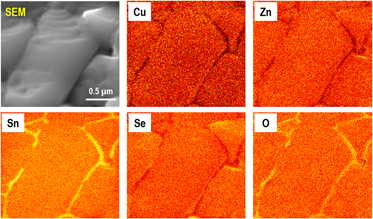Article contents
Nano-scale compositional analysis of surfaces and interfaces in earth-abundant kesterite solar cells
Published online by Cambridge University Press: 02 November 2016
Abstract

Kesterite Cu2ZnSn(S,Se)4 (CZTSSe) absorbers are considered promising alternatives to commercial thin film technologies including CdTe and Cu(In,Ga)Se2 (CIGSe) owing to the earth abundance and non-toxicity of their constituents. However, to be competitive with the existing technologies, the photovoltaic performance of CZTSSe solar cells needs to be improved beyond the current record conversion efficiency of 12.6%. In this study, nanoscale elemental mapping using Auger nanoprobe microscopy (NanoAuger) and nano secondary ion mass spectrometry (NanoSIMS) are used to provide a clear picture of the compositional variations between the grains and grain boundaries in Cu2ZnSn(S,Se)4 kesterite thin films. NanoAuger measurements revealed that the top surfaces of the grains are coated with a Zn-rich (Zn,Sn)Ox layer. While thick oxide layers were observed at the grain boundaries, their chemical compositions were found to be closer to SnOx . NanoSIMS elemental maps confirmed the presence of excess oxygen deeper within the grain boundary grooves, as a result of air annealing of the CZTSSe films.
- Type
- Invited Feature Paper
- Information
- Copyright
- Copyright © Materials Research Society 2016
References
REFERENCES
- 4
- Cited by



